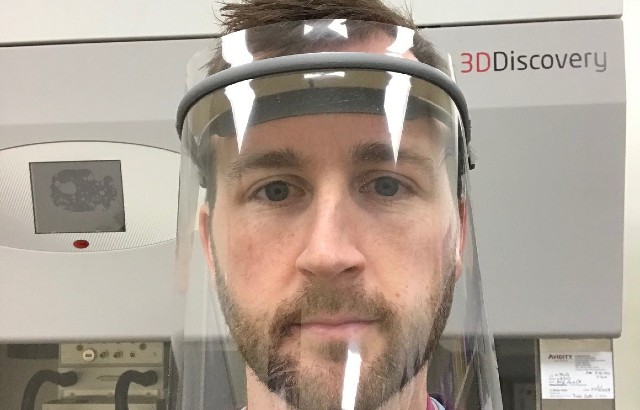Queen Mary 3D-prints protective equipment for COVID-19 NHS workers
The Queen Mary University of London community, including researchers, clinicians and support staff, have stepped in to assist the NHS with urgent requirements of personal protective equipment (PPE) to combat the outbreak of COVID-19.

Dr John Connelly wearing the new 3D-printed visor
PPE protects NHS workers against catching coronavirus through droplet transmission while caring for infected patients. It includes items such as safety visors, gloves and eye protection, among other things. Due to the increased demand during the outbreak of COVID-19, there has been a shortage of PPE available for these workers.
The Blizard Institute is working with colleagues in the university’s School of Engineering and Materials Science, School of Electronic Engineering and Computer Science, the Institute of Dentistry and Barts Health NHS Trust to 3D print new visors for front line staff at The Royal London Hospital.
The newly designed single-piece visor can hold acetate sheets to provide full face and neck protection for use during consultations and aerosol-generating procedures. The head bands are re-usable after disinfection with alcohol wipes or when submersed in disinfecting solution, and the acetate and elastic band are disposable. The design has been approved by the Barts Health Infection Control team for use in the Emergency Department, Critical Care Unit and other wards.
Barts Charity has awarded £25,000 to assist in the production, which would allow the team to create nearly 10,000 visors by using commercial printing facilities. Batch.works, a London based design and printing company, has agreed to print a sample of the design and if it is fit for purpose they will commit to printing 10,000 visors.
Project co-ordinator Professor Shakeel Shahdad from Queen Mary’s Institute of Dentistry said: “The ingenuity of the combined team has allowed us to start immediate in-house production of 3D printed visors. Our aim is to equip all clinical staff with 3D printed visors and expand out into producing these with faster and higher volumes with injection moulded designs in the coming weeks.”
Professor Shahdad’s team is now in talks with Halma, a FTSE50 company, which has committed to tooling and supplying 10,000 injection moulded visors.
Reader in Bioengineering, Dr John Connelly, added: “Professor Shahdad sent out a call last week to those labs with 3D printing capability to ask for assistance in 3D printing visors for face masks. The original visor design has been successfully modified by the Robotics team in collaboration with Queen Mary spinoff company, Keratify, to improve the printing efficiency and stability.
“At the moment, there are around five to six groups at Queen Mary printing visors and sending them over to the Institute of Dentistry where Professor Shahdad’s team is attaching the face shield and elastic bands, before passing them over to The Royal London Hospital. Although it’s still a fairly small-scale operation, the aim is to provide front line NHS staff with some additional PPE that is in short supply.”